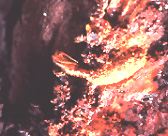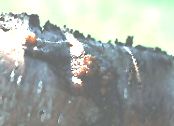II. Hosts: Peach and nectarine are the preferred hosts, but all stone fruits may be attacked. It may be common in black knot galls on plum.
III. Description: Adults are 1/2 inch long (13 mm), clear-winged moths that resemble wasps (photo above). The wingspan is 6/10 - 1 inch (15-26 mm). Females are somewhat larger than males. Both sexes are metallic blue-black with pale-yellow bands on the second and fourth abdominal segments (photo). Eggs are oval, cinnamon colored and less than one mm in size. Mature larvae (left photo below) are 3/4 to 1 inch (9-25 mm) long, with a yellowish-brown head and creamy white body. The pupal stage (right photo below) is light brown and about 1/2 inch (12-13 mm) in length. Cocoons, in which pupation occurs, are constructed of pieces of bark and frass (larval excrement) held together by silk. Initially yellowish-brown in color, cocoons become rust brown as they age.

IV. Biology: LPTB overwinters in galleries under the tree bark as a larva in various stages of development ranging from young to nearly full-grown. In the spring, larvae resume feeding and complete their development beneath a thin layer of the bark surface from pink to shuck-fall. Following construction of a cocoon the larva changes to the pupal stage. In 3 to 4 weeks the pupa pushes through the cocoon and the thin bark surface, the pupal case splits open, and the moth emerges. Moth flight begins around shuck-split or shuck-fall and continues for 6-8 weeks. A second generation occurs from July through September. Moths are active during the day, with mating and oviposition occurring soon after emergence. Female moths are attracted to damaged and previously infested trees and deposit eggs in cracks or under bark scales of wounded sites. Eggs hatch in 7 to 10 days and larvae burrow, feed and develop in the inner bark and cambium tissue for 40 to 60 days.
V. Injury: Infestation is almost always associated with previously damaged trees. The problem tends to be more severe in older orchards that have a greater incidence of Cytospora canker, winter injury, and pruning and other mechanical wounds. LPTB infestation occurs in these damaged bark areas from the ground to a height of 8 feet (2.4 m), with the majority in the upper trunk and scaffold limbs (photo below). Older wounds appear dark due to the exudation of gum which oxidizes. Larval feeding enlarges the wounded area which eventually results in complete girdling of the trunk or limb. The primary and earliest impact is a gradual decline in production on damaged limbs, which when girdled will break under a fruit load. With time, tree loss will occur from trunk girdling. LPTB feeding can also afford entry for disease organisms, eventually resulting in limb and tree death.

VI. Monitoring: Install a pheromone trap at petal fall for monitoring male LPTB emergence. Inspect wounded areas on the upper trunk, scaffold limbs and branches when moth flight is increasing to determine the average number of empty pupal cases/tree observed protruding from the bark (Plate 123). Begin inspecting wounds for fresh gum mixed with wood borings and sawdust-like frass (Plate 124) approximately 3 to 4 weeks after the start of moth flight for each generation. Clear gum without particles is not the result of borer injury. A management strategy should be implemented if there are more than a total of two larvae or empty pupal cases per tree for each generation of LPTB.
The second generation of LPTB and most individuals of the single PTB generation are active during mid and late season (3-16 weeks postbloom). Both species may be monitored using pheromone traps. For PTB, inspect the base of trees for an exudation of gum containing frass and sawdust. Determine the average number of cocoons and empty pupal cases in the soil at or near the base of the tree. A management strategy is recommended for trees up to three years old if any evidence of PTB infestation is detected. In older orchards, an average of more than one cocoon and/or empty pupal case per tree would warrant treatment. Experience has shown that populations seldom need treatment when trap catches peak at less than 10 moths/trap/week.
For LPTB, inspect wounded areas on the upper trunk, scaffold limbs and branches when moth flight is increasing to determine the average number of empty pupal cases/tree observed protruding from the bark. Begin inspecting wounds for fresh gum mixed with wood borings and sawdust-like frass approximately 3 to 4 weeks after the start of moth flight for each generation. Clear gum without particlesis not the result of borer injury. A management strategy should be implemented if there are more than a total of two larvae or empty pupal cases per tree for each generation of LPTB.
See Virginia Tech Factsheet, and factsheets from West Virginia, Ohio, Michigan, Texas, Kentucky
VII. Management: Mating Disruption is the preferred method of control for lesser peachtree borer, and is available for this species through Pacific Biocontrol. This is available either as a stand-alone product, or a combined dispenser for peachtree borer and lesser peachtree borer. Lesser peachtree borer has been the subject of research on mating disruption in Virginia and Pennsylvania. Control of LPTB has exceeded that provided by chlorpyrifos (in terms of total elimination of male captures, and pupal
skin counts). The most effective material used as a trunk spray, chlorpyrifos, was recently lost. Other materials that may be used are neem (Aza-Direct and Neemix), and carbaryl (Sevin) (follow label guidelines). Chlorpyrifos, formerly applied immediately after harvest, is no longer available. The alternative materials may need to be applied weekly during moth flight.